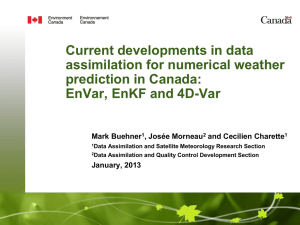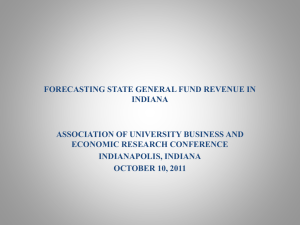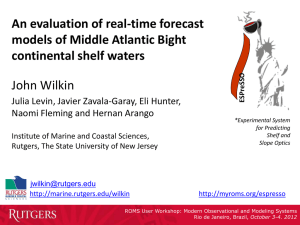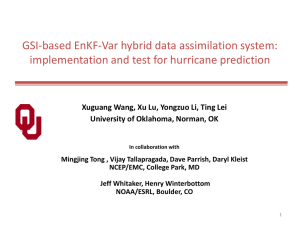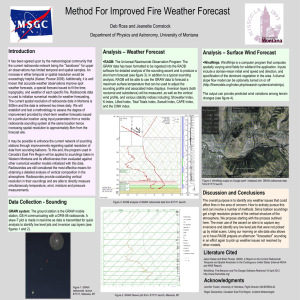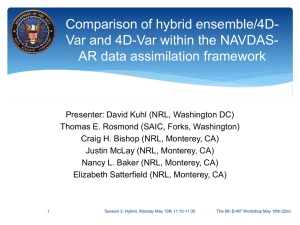Buehner_envar_birs
advertisement
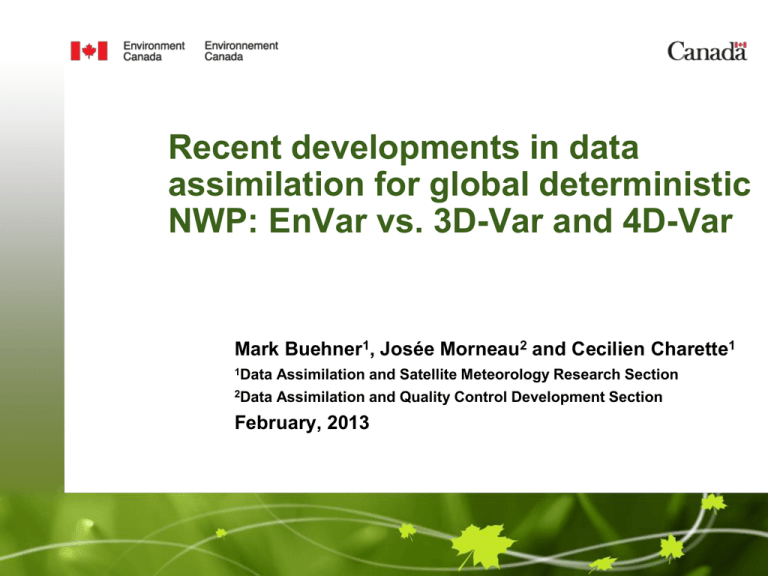
Recent developments in data assimilation for global deterministic NWP: EnVar vs. 3D-Var and 4D-Var Mark Buehner1, Josée Morneau2 and Cecilien Charette1 1Data Assimilation and Satellite Meteorology Research Section 2Data Assimilation and Quality Control Development Section February, 2013 Contents • Background • The ensemble-variational (EnVar) data assimilation approach • Recent results from using EnVar compared with standard 3D-Var and 4D-Var (but NO comparisons with 4D-VarBens or EnKF) • Conclusions and next steps Page 2 – April-7-15 Background • Environment Canada currently has 2 relatively independent state-ofthe-art global data assimilation systems • 4D-Var (Gauthier et al 2007) and EnKF (Houtekamer et al 2009): – both operational since 2005 – both use GEM forecast model and assimilate similar set of observations – current effort towards unifying code of the two systems • 4D-Var is used to initialize medium range global deterministic forecasts (GDPS) • EnKF is used to initialize global ensemble forecasts (GEPS) • Intercomparison of approaches and various hybrid configurations was performed in carefully controlled context: similar medium-range forecast quality from EnKF and 4D-Var analyses, 4D-Var-Ben best • Results presented at WMO workshop on intercomparison of 4D-Var and EnKF, Buenos Aires, 2008 (Buehner et al 2010, MWR) Page 3 – April-7-15 Ensemble-Variational assimilation: EnVar • EnVar approach is currently being tested in the context of replacing 4D-Var in the operational Global Deterministic Prediction System • EnVar uses a variational assimilation approach in combination with the already available 4D ensemble covariances from the EnKF • By making use of the 4D ensembles, EnVar performs a 4D analysis without the need of the tangent-linear and adjoint of forecast model • Consequently, it is more computationally efficient and easier to maintain/adapt than 4D-Var • Hybrid covariances can be used in EnVar by averaging the ensemble covariances with the static NMC-method covariances • Like 4D-Var, EnVar uses an incremental approach with: – analysis increment at the horizontal/temporal resolution of EnKF ensembles – background state and analysis at the horizontal/temporal resolution of the higher-resolution deterministic forecast model Page 4 – April-7-15 EnVar formulation • In 4D-Var the 3D analysis increment is evolved in time using the TL/AD forecast model (here included in H4D): J (x ) 1 2 • T 1 1 x B x T 2 In EnVar the background-error covariances and analysed state are explicitly 4-dimensional, resulting in cost function: J ( x 4D ) • 1 ( H 4D [ x b ] H 4D x y ) R ( H 4D [ x b ] H 4D x y ) 1 2 1 ( H 4D [ x b ] H x 4D y ) R ( H 4D [ x b ] H x 4D y ) T 1 2 T 1 x 4D B 4D x 4D Computations involving ensemble-based B4D can be more expensive than with Bnmc depending on ensemble size and spatial/ temporal resolution, but significant parallelization is possible Page 5 – April-7-15 4D error covariances Temporal covariance evolution (explicit vs. implicit evolution) EnKF and EnVar (4D B matrix): 192 NLM integrations provide 4D background-error covariances 4D-Var: TL/AD inner loop integrations, 2 outer loop iterations, then 3h NLM forecast -3h 0h Page 6 – April-7-15 “analysis time” +3h EnVar: a possible replacement of 4D-Var Overall, EnVar analysis ~6X faster than 4D-Var on half as many cpus, even though higher resolution increments Wall-clock time of 4D-Var already close to allowable time limit; increasing number of processors has negligible impact To progress with 4D-Var, significant work would be required to improve scalability of TL/AD versions of forecast model at resolutions and grid configuration used in 4D-Var Current focus for model is on development of higherresolution global Yin-Yang configuration that scales well Decision made to try to replace 4D-Var with more efficient EnVar if EnVar is at least as good as current 4D-Var Page 7 – April-7-15 Dependencies between global systems • GDPS: Current system (1-way dependence): xb Bgcheck+BC xb, obs 4D-Var xa GEM (9h fcst) xb obs GEPS: • xb EnKF xa GEM (9h fcst) xb GEPS relies on GDPS to perform quality control (background check) for all observations and bias correction for satellite radiance observations Page 8 – April-7-15 Dependencies between global systems • GDPS: Current system (1-way dependence): xb Bgcheck+BC xb, obs 4D-Var xa GEM (9h fcst) xb obs GEPS: • GDPS: GEPS: • xb EnKF xa GEM (9h fcst) xb With EnVar (2-way dependence): xb xb Bgcheck+BC xb xb, obs EnVar obs EnKF xa xa GEM (9h fcst) GEM (9h fcst) xb xb 2-way dependence (EnVar uses EnKF ensemble of background states) increases complexity of overall system 2 systems have to be run simultaneously Page 9 – April-7-15 EnVar formulation: Preconditioning • Preconditioned cost function formulation at Environment Canada: J (ξ ) 1 ξ ξ T 2 • 1 2 ( H 4D x b H x ξ y ) R T ( H 4D x b H x ξ y ) In EnVar with hybrid covariances, the control vector (x) is composed of 2 vectors: ξ 1ens ξ nmc ξ ξ ens • 1 ξ N en s ens ξ ens The analysis increment is computed as (ek is k’th ensemble perturbation divided by sqrt(Nens-1) ): x ξ nmc B nmc ξ nmc ens 1/ 2 1/2 1/ 2 N ens 1/2 k e k L ξ ens B nmc B nmc ens N en s e T e L k k k 1 k 1 • Better preconditioned than original “alpha control vector” formulation (with L-1 and 1/β in background term of J) • Most, but maybe not all, applications of the approach use the better preconditioned formulation Page 10 – April-7-15 Experimental results: Configuration EnVar tested in comparison with new version of forecast system recently implemented in operations: • model top at 0.1hPa, 80 levels • model has ~25km grid spacing • 4D-Var analysis increments with ~100km grid spacing EnVar experiments use ensemble members from new configuration of EnKF: • 192 members every 60min in 6-hour window • model top at 2hPa, 75 levels • model ~66km grid spacing EnVar increments ~66km Page 11 – April-7-15 EnVar uses Hybrid Covariance Matrix Model top of EnKF is lower than GDPS Therefore, EnVar not expected to be better than 3D-Var above ~10-20hPa Also tested 75% Bens and 25% Bnmc in troposphere, but results slightly worse pressure Bens and Bnmc are averaged in troposphere ½ & ½, tapering to 100% Bnmc at and above 6hPa (EnKF model top at 2hPa) Also did preliminary tests with a full outer loop, but degraded the results Page 12 – April-7-15 Bens scale factor Bnmc scale factor scale factor Forecast Results: EnVar vs. 3D-Var and 4D-Var Radiosonde verification scores – 6 weeks, Feb/Mar 2011 U GZ T-Td |U| T EnVar vs. 3D-Var 120h forecast North extra-tropics Page 13 – April-7-15 Forecast Results: EnVar vs. 3D-Var and 4D-Var Radiosonde verification scores – 6 weeks, Feb/Mar 2011 U GZ T-Td |U| T EnVar vs. 3D-Var 120h forecast North extra-tropics Page 14 – April-7-15 U GZ T-Td |U| T EnVar vs. 4D-Var 120h forecast North extra-tropics Forecast Results: EnVar vs. 3D-Var and 4D-Var Radiosonde verification scores – 6 weeks, Feb/Mar 2011 U GZ T-Td |U| T EnVar vs. 3D-Var 120h forecast South extra-tropics Page 15 – April-7-15 Forecast Results: EnVar vs. 3D-Var and 4D-Var Radiosonde verification scores – 6 weeks, Feb/Mar 2011 U GZ T-Td |U| T EnVar vs. 3D-Var 120h forecast South extra-tropics Page 16 – April-7-15 U GZ T-Td |U| T EnVar vs. 4D-Var 120h forecast South extra-tropics Forecast Results: EnVar vs. 3D-Var and 4D-Var Radiosonde verification scores – 6 weeks, Feb/Mar 2011 U GZ T-Td |U| T EnVar vs. 3D-Var 24h forecast Tropics Page 17 – April-7-15 Forecast Results: EnVar vs. 3D-Var and 4D-Var Radiosonde verification scores – 6 weeks, Feb/Mar 2011 U GZ T-Td |U| T EnVar vs. 3D-Var 24h forecast Tropics Page 18 – April-7-15 U GZ T-Td |U| T EnVar vs. 4D-Var 24h forecast Tropics Forecast Results: EnVar vs. 3D-Var and 4D-Var Verification against ERA-Interim analyses – 6 weeks, Feb/Mar 2011 EnVar vs. 3D-Var 120h forecast, global domain no EnKF covariances transition zone no EnKF covariances transition zone ½ EnKF and ½ NMC covariances ½ EnKF and ½ NMC covariances EnVar vs. 4D-Var U RH U RH GZ T GZ T Page 19 – April-7-15 Forecast Results: EnVar vs. 3D-Var and 4D-Var Verification against ERA-Interim analyses – 6 weeks, Feb/Mar 2011 North extra-tropics 500hPa GZ correlation anomaly EnVar vs. 3D-Var EnVar vs. 4D-Var Page 20 – April-7-15 Forecast Results: EnVar vs. 3D-Var and 4D-Var Verification against ERA-Interim analyses – 6 weeks, Feb/Mar 2011 South extra-tropics 500hPa GZ correlation anomaly EnVar vs. 3D-Var EnVar vs. 4D-Var This is the only significant degradation seen vs. 4D-Var in troposphere; Not in radiosonde scores because it originates from south of 45°S (see next slide) Page 21 – April-7-15 Forecast Results: EnVar vs. 3D-Var and 4D-Var Verification against ERA-Interim analyses – 6 weeks, Feb/Mar 2011 Tropics 250hPa U-wind STDDEV EnVar vs. 3D-Var EnVar vs. 4D-Var Page 22 – April-7-15 Forecast Results: EnVar vs. 3D-Var and 4D-Var Verification against ERA-Interim analyses – 6 weeks, July-Aug 2011 North extra-tropics 500hPa GZ correlation anomaly EnVar vs. 3D-Var EnVar vs. 4D-Var Page 23 – April-7-15 Forecast Results: EnVar vs. 3D-Var and 4D-Var Verification against ERA-Interim analyses – 6 weeks, July-Aug 2011 South extra-tropics 500hPa GZ correlation anomaly EnVar vs. 3D-Var EnVar vs. 4D-Var Page 24 – April-7-15 Forecast Results: EnVar vs. 3D-Var and 4D-Var Verification against ERA-Interim analyses – 6 weeks, July-Aug 2011 Tropics 250hPa U-wind STDDEV EnVar vs. 3D-Var EnVar vs. 4D-Var Page 25 – April-7-15 Experimental results: 4D-EnVar vs. 3D-EnVar 3D version of EnVar also tested: only uses EnKF flowdependent ensembles valid at the centre of the 6h assimilation window, instead of every 60 minutes throughout the window 3D-EnVar compared with: • 4D-EnVar: impact of 4D vs 3D covariances, and • 3D-Var: impact of flow dependent vs stationary (NMC) covariances (both 3D) Page 26 – April-7-15 Forecast Results: 4D-EnVar vs. 3D-EnVar Verification against ERA-Interim analyses – 4 weeks, Feb 2011 North extra-tropics 500hPa GZ correlation anomaly 4D-EnVar vs. 3D-EnVar 3D-EnVar vs. 3D-Var Page 27 – April-7-15 Forecast Results: 4D-EnVar vs. 3D-EnVar Verification against ERA-Interim analyses – 4 weeks, Feb 2011 South extra-tropics 500hPa GZ correlation anomaly 4D-EnVar vs. 3D-EnVar 3D-EnVar vs. 3D-Var Page 28 – April-7-15 Forecast Results: 4D-EnVar vs. 3D-En-Var Verification against ERA-Interim analyses – 4 weeks, Feb 2011 Tropics 250hPa U-wind STDDEV 4D-EnVar vs. 3D-EnVar 3D-EnVar vs. 3D-Var Page 29 – April-7-15 Conclusions • Comparison of EnVar with 3D-Var and 4D-Var: – EnVar produces similar quality forecasts as 4D-Var below ~20hPa in extra-tropics, significantly improved in tropics – above ~20hPa, scores similar to 3D-Var, worse than 4D-Var; potential benefit from raising EnKF model top to 0.1hPa • EnVar is an attractive alternative to 4D-Var: – like EnKF, uses full nonlinear model dynamics/physics to evolve covariances; no need to maintain TL/AD version of model – instead, makes use of already available 4D ensembles – more computationally efficient and easier to parallelize than 4DVar for high spatial resolution and large data volumes – computational saving allows increase in analysis resolution and volume of assimilated observations; more computational resources for EnKF and forecasts Page 30 – April-7-15 Next Steps • Finalize testing EnVar with goal of replacing 4D-Var in operational global prediction system during 2013 in combination with other changes: – modified satellite radiance bias correction scheme that gives conventional observations more influence on correction – improved use of radiosonde and aircraft data – additional AIRS/IASI channels and modified observation error variances for all radiances – GEM global model: 25km lat-lon grid 15km Yin-Yang grid – CALDAS: new surface analysis system based on an EnKF – EnKF: increased resolution 66km 50km and ensemble size 192 256 members • Early results from using EnVar in regional prediction system as 4D-Var replacement look promising Page 31 – April-7-15 Humidity analysis • After combining EnVar with new bias correction and improved treatment of radiosonde/aircraft data, compared with 4D-Var: – humidity analysis significantly changed: both fit to humidity sensitive radiances and mean humidity – mass and wind medium-range (day 4 and after) forecast error std dev significantly degraded Page 32 – April-7-15 Humidity analysis • Just replacing EnVar humidity analysis with 4D-Var humidity analysis improves medium-range forecast error std dev, but introduces increased temperature bias at ~200hPa • Now trying to modify EnVar B matrix and bias correction scheme to obtain more similar humidity analysis as 4D-Var Page 33 – April-7-15 Some extra slides follow Page 34 – April-7-15 Model Dynamics: New approaches for global grids Page 35 – April-7-15 Proposed Upgrades and Improvements to the MSC Data Processing for Radiosonde and Aircraft Data • Increased volume of data: selection of observations according to model levels • Revised observation error statistics • Revised rejection criteria for radiosonde data based on those used at ECMWF • Horizontal drift of radiosonde balloon taken into account in both data assimilation and verification systems • Bias correction scheme for aircraft temperature reports wind speed temperature operational 12h 48h proposed for both radiosonde & aircraft Impact of proposed changes • General short-range forecast improvements above 500 hPa in both wind and temperature fields • The temperature forecast biases are significantly improved due to the bias correction scheme for aircraft below 200 hPa and to the new rejection criteria for Page 36 – April-7-15 radiosonde humidity data above Fig: Verification scores against radiosondes over the N. Hemisphere, Jan-Feb 2009 (dash = bias; solid = stde) 2013-2017: Toward a Reorganization of the NWP Suites at Environment Canada Role of Ensembles… Perturbed members of the global prediction system (GPS) Global EnKF Regional EnKF Background error covariances Regional En-Var ? Background error covariances Global En-Var Control member of the global prediction system (GPS) global system High-res En-Var Page 37 – April-7-15 Perturbed members of the regional prediction system (RPS) Control member of the regional prediction system (RPS) High-resolution deterministic prediction system (HRDPS) regional system Forecast Results: EnVar vs. 3D-Var and 4D-Var Verification against ERA-Interim analyses – 6 weeks, Feb/Mar 2011 EnVar vs. 3D-Var 48h forecast, global domain no EnKF covariances transition zone ½ EnKF and ½ NMC covariances U RH GZ T Page 38 – April-7-15 Forecast Results: EnVar vs. 3D-Var and 4D-Var Verification against ERA-Interim analyses – 6 weeks, Feb/Mar 2011 EnVar vs. 3D-Var 48h forecast, global domain no EnKF covariances transition zone no EnKF covariances transition zone ½ EnKF and ½ NMC covariances ½ EnKF and ½ NMC covariances EnVar vs. 4D-Var U RH U RH GZ T GZ T Page 39 – April-7-15 Forecast Results: EnVar vs. 3D-Var and 4D-Var Verification against ERA-Interim analyses – 6 weeks, Feb/Mar 2011 EnVar vs. 3D-Var 120h forecast, global domain no EnKF covariances transition zone ½ EnKF and ½ NMC covariances U RH GZ T Page 40 – April-7-15 Forecast Results: EnVar vs. 3D-Var and 4D-Var Verification against ERA-Interim analyses – 6 weeks, Feb/Mar 2011 EnVar vs. 3D-Var 120h forecast, global domain no EnKF covariances transition zone no EnKF covariances transition zone ½ EnKF and ½ NMC covariances ½ EnKF and ½ NMC covariances EnVar vs. 4D-Var U RH U RH GZ T GZ T Page 41 – April-7-15 Single observation experiments Difference in temporal covariance evolution EnVar • radiosonde • • • temperature observation at 500hPa observation at beginning of assimilation window (-3h) with same B, increments very similar from 4D-Var, EnKF contours are 500hPa GZ background state at 0h (ci=10m) + + contour plots at 500 hPa + + Page 42 – April-7-15 Single observation experiments Difference in temporal covariance evolution EnVar • radiosonde • • • temperature observation at 500hPa observation at middle of assimilation window (+0h) with same B, increments very similar from 4D-Var, EnKF contours are 500hPa GZ background state at 0h (ci=10m) + + contour plots at 500 hPa + + Page 43 – April-7-15 Single observation experiments Difference in temporal covariance evolution EnVar • radiosonde • • • temperature observation at 500hPa observation at end of assimilation window (+3h) with same B, increments very similar from 4D-Var, EnKF contours are 500hPa GZ background state at 0h (ci=10m) + + contour plots at 500 hPa + + Page 44 – April-7-15 Dependencies between global systems • GDPS: Current system (1-way dependence): xb Bgcheck+BC xb, obs 4D-Var xa GEM (9h fcst) xb obs GEPS: • GDPS: GEPS: • GDPS: xb EnKF xa GEM (9h fcst) xb With EnVar (2-way dependence): xb xb Bgcheck+BC xb, obs xb EnVar obs EnKF xa xa GEM (9h fcst) GEM (9h fcst) xb xb Another possibility with EnVar (1-way dependence): xb Bgcheck+BC xb, obs EnVar xa GEM (9h fcst) xb xb GEPS: xb Bgcheck+BC xb, obs EnKF Page 45 – April-7-15 xa GEM (9h fcst) xb
